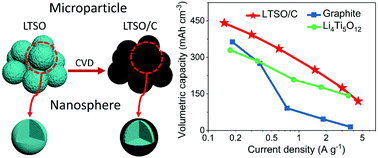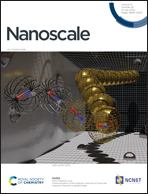CVD-assisted fabrication of hierarchical microparticulate Li2TiSiO5-carbon nanospheres for ultrafast lithium storage†
Abstract
Particular recent interest has been given to the Li2TiSiO5 (LTSO) anode material owing to its low lithiation potential (0.28 V vs. Li/Li+) and decent theoretical capacity (308 mA h g−1). However, its poor electronic conductivity (∼10−7 S m−1) fundamentally limits the utilization of this material, and current strategies fail to tackle such issues in practical ways. Herein, a hierarchical microparticulate LTSO-carbon composite (LTSO/C) is fabricated by chemical vapor deposition (CVD), where microsized LTSO/C particles assembled from nanospheres guarantee a practical tap density of ∼1.3 g mL−1. Meanwhile, significantly elevated conductivity of LTSO/C (∼103 S m−1) is achieved by a thin layer (15 nm) of graphitic carbon growth on LTSO, which is theoretically catalyzed by the surface functional groups on the parent LTSO. The electrochemical characterization of LTSO/C reveals a superior graphite-like volumetric capacity of 441.1 mA h cm−3 and Li4Ti5O12-like rate capability (120.1 mA h cm−3 at 4.5 A g−1), providing inspiring guidance for designing analogous Ti or Si-based compounds for ultrafast lithium storage materials.



 Please wait while we load your content...
Please wait while we load your content...